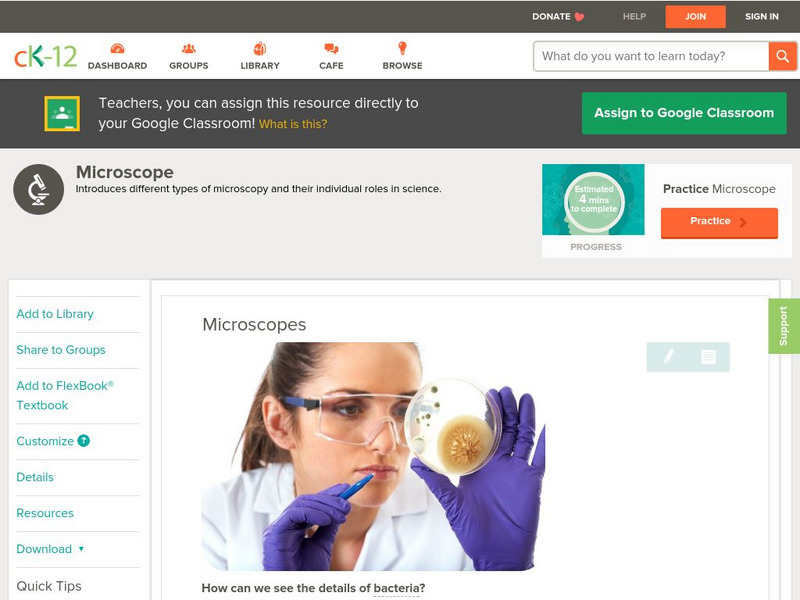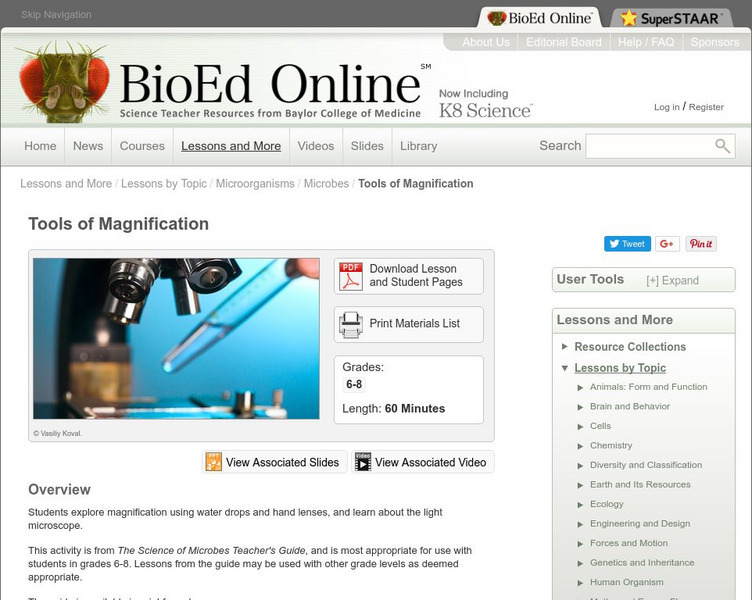Hi, what do you want to do?
Curated OER
Holey Clamshells
Pupils analyze data to make hypotheses and conclusions regarding the predator/prey relationship between moon snail and surf clams.
Curated OER
My Favorite Biology Supplies
Here are some biology laboratory supplies that I can't live without.
Curated OER
Phytoplankton and Ocean Color
Fifth graders identify function of phytoplankton in the biospere by conducting experiments and simulations and reading for information. They detect the presence of phytoplankton in bodies of water by examining ocean in satellite images...
Curated OER
The Classification of the Kingdoms of Life
Students can learn about the evolution of science by discussing the classification of living things.
Curated OER
What Color is the Ocean?
Pupils view satellite pictures of the ocean, and discuss the presence of phytoplankton and the colors of the ocean. Students compare/contrast ocean satellite images with maps and globes, then color world maps to replicate the satellite...
Curated OER
Cell Swelling and Shrinking
Students examine the concept of osmosis in relation to dehydration. They identify the function and structure of semi-permable membranes. They predict how certain processes can affect the characteristics of an organism.
Curated OER
Classification
Fifth graders analyze the necessity of classification. They distinguish between living and nonliving things in our world and recognize the six life functions of living things by identifying 15 classroom objects.
Curated OER
Transistor Hunt
Students locate transistor devices in school. They explain the importance of transistors.
Curated OER
Inquiry-based Investigations into Pond Water Microorganisms
Students become familiar with common microorganisms and experience exploring the microbial world.
Curated OER
Let it Grow!
Students explain the relationship of plants and animals in the environment. They name the basic requirements for plant growth and define the terms photosynthesis, stomata, chlorophyll and xylem.
Curated OER
Water Purification
Students develop an understanding and appreciation of water purification techniques and their implications for health maintenance.
Curated OER
Home Sweet Home
Students examine the animals that live in trees. They identify their sounds, footprints and droppings. They draw pictures of the animals as well.
Curated OER
One Square Foot
Students identify, describe, count, tally, and graph life found in one square foot of land.
Curated OER
Quantum Mechanics and Atomic Physics
Students will discuss the de Brogile Hypothesis and state the circumstances under which the wave nature of matter is observed. They will also calculate the wavelengths of matter waves.
Curated OER
Bioremediation
Learners design and conduct investigations that illustrate the effect bioremediation has on organic matter and determine environmental applications. They, in groups, present their findings to the class.
Curated OER
There Are Algae in Your House!
Learners demonstrate that, although we sometimes can neither smell nor taste them, many ingredients in our foods and household products come from the sea. They also investigate food eat to determine algae derivatives they contain.
Curated OER
What's Making It Look So Brown Outside?
Ninth graders analyze cars and particulate matter in the atmosphere. They analyze results of particulate pollutants and identify which vehicle gives off more particulates. They identify sources of particulate matter and relate to...
Curated OER
Breaking News English: Fleas Have Organ-Saving Antifreeze
In this English instructional activity, students read "Fleas Have Organ-Saving Antifreeze," and then respond to 47 fill in the blank, 7 short answer, 20 matching, and 8 true or false questions about the selection.
CK-12 Foundation
Ck 12: Life Science: Microscopes
[Free Registration/Login may be required to access all resource tools.] A microscope is a tool used to make things that are too small to be seen by the human eye look bigger. Before microscopes were invented in 1595, the smallest things...
Alabama Learning Exchange
Alex: Introduction to the Light Microscope
This is a Microscope Internet Lab that can be used as a virtual lab for a whole class or as a make-up lab. The virtual microscope is a little more complicated than the microscope that is used in the labs but it will not be difficult to...
BioEd Online
Bio Ed Online: The Science of Microbes: Observing Different Microbes
Young scholars prepare slides of and examine three types of common microbes using a light microscope, recording what they observe. The lesson and a set of PowerPoint slides can be downloaded. An accompanying instructional video is 22...
BioEd Online
Bio Ed Online: The Science of Microbes: Tools of Magnification
The invention of magnifiers that allow us to see things that are otherwise invisible to us has revolutionized science. In this instructional activity, students use several types of magnifiers to investigate magnification, and record...
Michigan Reach Out
Guess What! A Lesson About Atoms
A lesson plan outlining a very simple way to introduce students to how the structure of the atom was determined. Uses a mystery box with surprise items inside.




























